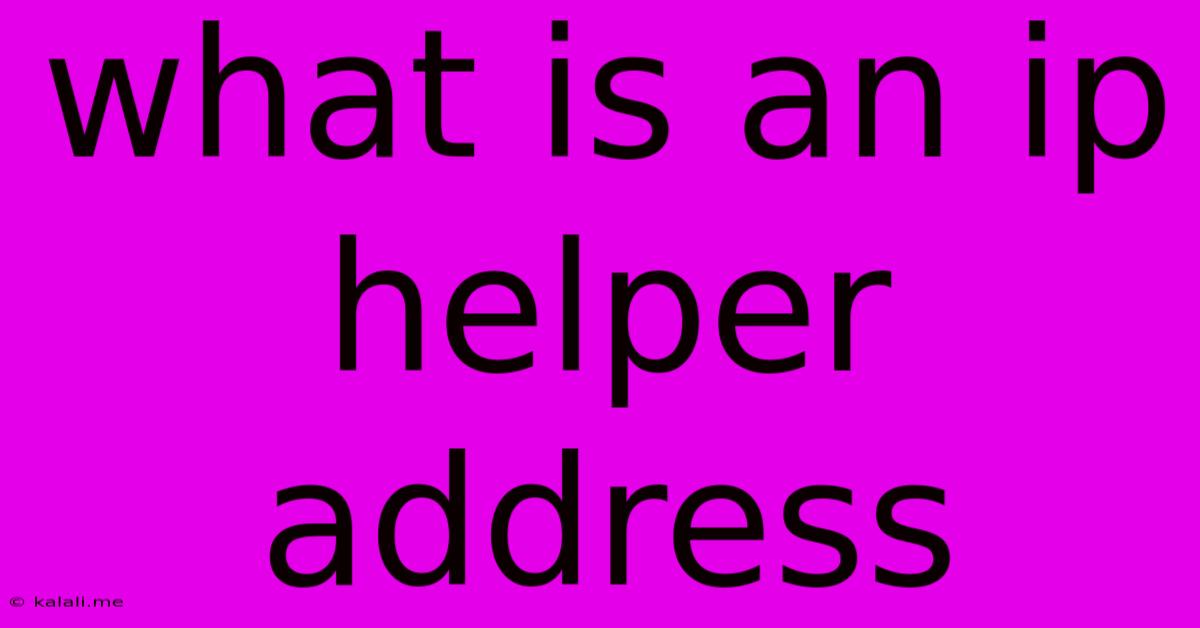What Is An Ip Helper Address
Kalali
Jun 01, 2025 · 3 min read

Table of Contents
What is an IP Helper Address? A Comprehensive Guide
Meta Description: Learn all about IP helper addresses – what they are, how they work, their benefits, and when you should use them. This comprehensive guide simplifies a complex networking concept.
Understanding IP helper addresses is crucial for anyone managing or troubleshooting networks, especially those relying on routing protocols like RIP or static routing. This article provides a clear explanation of IP helper addresses, their functionality, and practical applications.
What are IP Helper Addresses?
An IP helper address, in essence, is a workaround for limitations in routing protocols. It allows a router to forward broadcast traffic, typically related to network management protocols like DHCP and BOOTP, to a designated server located on a different network segment. Imagine a situation where your DHCP server resides on a different subnet than the clients requesting IP addresses. Without an IP helper address, those DHCP requests would be lost, preventing clients from obtaining necessary network configuration. The helper address acts as a conduit, intelligently forwarding these broadcasts to their intended destination.
How IP Helper Addresses Work
The process is straightforward:
-
Broadcast Transmission: A client on a subnet sends a broadcast request (e.g., a DHCP Discover message). This broadcast is initially confined to its local subnet.
-
Router Intercept: The router on the client's subnet intercepts this broadcast. If the router is configured with an IP helper address for the relevant protocol (like DHCP), it performs the critical step of forwarding the broadcast.
-
Targeted Forwarding: Instead of flooding the entire network with the broadcast, the router specifically forwards the broadcast packet to the IP address specified as the helper address. This address points to the DHCP server's location on a different subnet.
-
Server Response: The DHCP server receives the request, processes it, and sends a response back to the client. The response follows the same path in reverse, guided by the router's routing table.
Benefits of Using IP Helper Addresses
- Efficient Broadcast Management: Prevents broadcast storms by limiting broadcast traffic to only the necessary devices.
- Simplified Network Management: Allows centralized management of network services, even across different subnets.
- Flexible Network Design: Enables more flexible subnet design without sacrificing network functionality.
- Cost-Effective Solution: Often a more cost-effective solution compared to implementing more complex routing protocols.
When to Use IP Helper Addresses
IP helper addresses are particularly beneficial in the following scenarios:
- DHCP Server on a Separate Subnet: This is the most common use case, where a DHCP server resides on a different subnet than the clients it serves.
- BOOTP Server on a Remote Network: Similar to DHCP, BOOTP servers often benefit from IP helper addresses for efficient client configuration.
- Other Network Management Protocols: While DHCP and BOOTP are prevalent, other network management protocols may also leverage IP helper addresses for efficient broadcast forwarding.
- Small to Medium-Sized Networks: They provide an elegant solution for managing broadcast traffic without the overhead of complex routing schemes.
Configuring IP Helper Addresses
The exact method for configuring IP helper addresses depends on the router's operating system (e.g., Cisco IOS, Juniper Junos). Generally, it involves specifying the IP address of the helper server under an interface configuration. Consult your router's documentation for specific instructions. This usually involves commands like ip helper-address (Cisco) or an equivalent setting within the router's GUI.
Alternatives to IP Helper Addresses
While IP helper addresses are a powerful tool, alternatives exist, depending on the network architecture:
- VLANs: Virtual LANs can logically segment networks, allowing DHCP servers to be located within the same broadcast domain as their clients.
- Layer 3 Switches: Advanced switches can handle routing, eliminating the need for dedicated routers in smaller networks.
- More Sophisticated Routing Protocols: Protocols like OSPF or EIGRP offer more robust routing solutions, but often add complexity.
In conclusion, IP helper addresses offer a practical and efficient way to manage broadcast traffic, especially in scenarios involving DHCP, BOOTP, and other network management protocols across different subnets. Understanding their functionality and application is vital for network administrators aiming for efficient and well-managed networks. Remember to always consult your specific router's documentation for precise configuration instructions.
Latest Posts
Latest Posts
-
Best Probability Book For Self Study
Jun 03, 2025
-
How To Know If A Proline Is Cis Or Trans
Jun 03, 2025
-
Why Is Macbook Monitor Display Disconnecting And Reconnecting Every Minute
Jun 03, 2025
-
How To Send An Imessage Instead Of Text
Jun 03, 2025
-
Recovery Is Trying To Change System Settings
Jun 03, 2025
Related Post
Thank you for visiting our website which covers about What Is An Ip Helper Address . We hope the information provided has been useful to you. Feel free to contact us if you have any questions or need further assistance. See you next time and don't miss to bookmark.